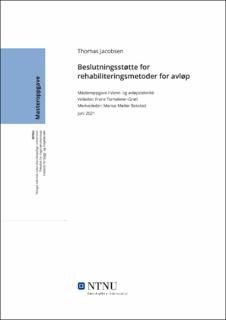| dc.contributor.advisor | Tscheikner-Gratl, Franz | |
| dc.contributor.advisor | Rokstad, Marius Møller | |
| dc.contributor.author | Jacobsen, Thomas | |
| dc.date.accessioned | 2021-10-03T16:40:24Z | |
| dc.date.available | 2021-10-03T16:40:24Z | |
| dc.date.issued | 2021 | |
| dc.identifier | no.ntnu:inspera:80614795:15148668 | |
| dc.identifier.uri | https://hdl.handle.net/11250/2787262 | |
| dc.description.abstract | Det norske ledningsnettet er preget av et stort etterslep for fornyelse av avløpsledninger. Det rehabiliteres kun 0,61% av ledningsnettet hvert år på landsbasis, og med en forventet levealder på 100 år går ikke dette regnestykket opp. Det er et stort behov for å fornye ledningsnettet, og dette bør gjøres på den mest bærekraftige og effektive metoden mulig. Kun 25% av kommuner i Norge viser til å ha benyttet gravefrie metoder, som viser at det er et stort potensial for gravefrie metoder i Norge, og at mange beslutningstakere velger konvensjonell graving som metode uten å ha undersøkt andre muligheter. Målet med denne oppgaven er å enklere kunne vise at det finnes andre metoder som vil være bedre å benytte, og at det ikke nødvendigvis vil være dyrere med gravefrie metoder i alle tilfeller.
Oppgaven er begrenset til ulike rehabiliteringsmetoder for avløpsledninger utført i eksisterende trasé. De ulike metodene som er undersøkt er utblokking, strømperenovering, tettilsluttet rør, rørinnføring og konvensjonell graving.
Oppgaven har bakgrunn i fordypningsarbeidet som ble gjennomført høsten 2020, hvor ulike rehabiliteringsmetoder for avløpsledninger ble undersøkt. Dette la grunnlaget for den tekniske gjennomføringsevnen til metodene undersøkt i denne oppgaven. Videre i arbeidet med denne oppgaven ble det undersøkt hvordan de ulike metodenes utførelse påvirker økonomiske-, sosiale- og miljøkostnader. Alle disse funnene ble kombinert sammen og inkludert i et multikriterie beslutningsstøtte (MCDM) verktøy som ble utviklet i denne oppgaven. Informasjonsinnhentingen er gjort ved litteratursøk og gjennom intervjuer av ulike entreprenører som leverer og utfører flere av metodene som er inkludert i oppgaven.
Resultatet av denne oppgaven er verktøyet som er utviklet. Verktøyet er todelt, hvor første del er et beslutningstre hvor metoder blir inkludert eller ekskludert avhengig av hva som er teknisk gjennomførbart for et prosjekt. Andre del er et multikriterie beslutningsstøtte verktøy som er utviklet i Excel som tar inn de aktuelle metodene og vurderer disse opp mot hverandre med hensyn til ulike underkriterier. MCDM delen av verktøyet benytter metoden analytisk hierarkiprosess, hvor det benyttes matriser for å parvis sammenligne to metoder om gangen. I dette verktøyet er det satt 950 ulike verdier fordelt over 41 matriser for hvordan metodene skårer gitt spesifikke faktorer og kriterier. | |
| dc.description.abstract | The Norwegian pipeline network is characterized by a large backlog for the renewal of sewage pipelines. Only 0.61% of the pipeline network is rehabilitated each year on a national basis, and with an life expectancy of 100 years, this calculation does not add up. There is a great need to renew the pipeline network, and this should be done in the most sustainable and efficient method possible. Only 25% of municipalities in Norway indicate that they have used NoDig-methods, which shows that there is a great potential for NoDig-methods in Norway, and that many decision-makers choose conventional digging as a method without having investigated other possibilities. The aim of this thesis is to more easily show that there are other methods that will be better to use, and that it will not necessarily be more expensive with NoDig-methods in all cases.
The thesis is limited to various rehabilitation methods for sewers carried out in existing routes. The various methods that have been investigated are pipe bursting, cured in place pipe, close fit lining, sliplining and conventional digging.
The thesis is based on the specialization work that was carried out in the autumn of 2020, where various rehabilitation methods for sewer lines were investigated. This laid the foundation for the technical feasibility of the methods investigated in this thesis. Furthermore, in the work on this thesis, it was investigated how the execution of the various methods affects economic, social and environmental costs. All these findings were combined together and included in a multi-criterion decision making (MCDM) tool that was developed in this thesis. The information gathering is done by literature search and through interviews of various contractors who deliver and perform several of the methods included in the thesis.
The result of this task is the tool that has been developed. The tool is divided into two parts, where the first part is a decision tree where methods are included or excluded depending on what is technically feasible for a project. The second part is a multi-criteria decision making tool developed in Excel that takes the relevant methods and evaluates them against each other with regard to various sub-criteria. The MCDM part of the tool uses the method analytical hierarchy process, where matrices are used to compair two methods at a time. In this tool, 950 different values are set over 41 matrices for how the methods score given specific factors and criteria. | |
| dc.language | nob | |
| dc.publisher | NTNU | |
| dc.title | Beslutningsstøtte for rehabiliteringsmetoder for avløp | |
| dc.type | Master thesis | |
